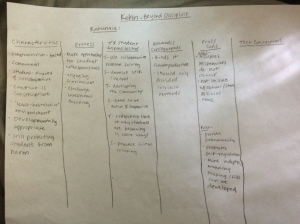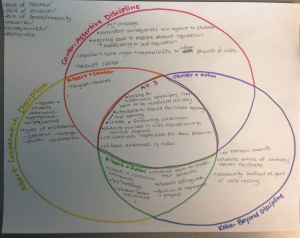Week 11: Kohn’s Beyond Discipline Theory & 3-Part Venn Diagram
As we are nearing the end of our first semester of the MAT program classroom management theories are really beginning to take shape. The more approaches or behaviors I learn of and witness in real time the more I am able to start recognizing what my teaching style will look like. Hypothetically, of course, because teaching behaviors and practices are circumstantial but just as many theorist provide “visions” of ideal classroom environments my own images are becoming more clear. Well, before I get to into my personal preferences let me honor my promise from last week and review the third discipline approach.
This week we analyzed Alfie Kohn’s vision of discipline in the classroom. Below you will find the graphic organizer I used to to analyze Kohn’s Beyond Discipline theory.
Do you remember my “light bulb” moment from last week? I described the reality check I had when I was “forced” to use a graphic organizer that became too distracting for my thought processes to focus on the task of analyzing Albert’s Cooperative Discipline Theory. I vowed that as a teacher I would provide many “tools” to my students because all minds do not organize and process information in the same way. This week I was quite pleased when I was advised to complete Kohn’s theory in ANY organizational style I desired. As it turns out I still felt limited in my layout because I would’ve preferred to use more color (ink or highlighters) to help me recognize ideas that fell into multiple columns. Honestly, its likely I’m overthinking it a bit because I was able to pull out main ideas but if given the chance I would create all of my organizers on poster boards using all different colors and fonts as I’m a visual learner.
Okay…I’m getting carried away but let’s check out what ideas Kohn brings to the management world. For me, the name alone immediately differentiates Kohn from Canter and Albert’s theory; Beyond Discipline. Kohn has criticized discipline practices deeming them counterproductive (especially reward and consequence systems). He claims they do things to students rather then involve students in the processes of classroom management and behavior regulations. Kohn’s approach is built upon the theory of Constructivism in which learning is identified as the cognitive experience of building on ideas and experiences. Kohn feels strongly that classrooms should reflect a community of engaged and self-regulated individuals who choose their behaviors and choose to learn as a collective. While his approach to management reminds me of how my graduate level classes are conducted part of me feels that it would be unlikely to succeed in elementary grade levels. One difference is the fact that I (and my cohorts) are willingly attending classes (that for some of us will take 5+ years to pay off financially) and are deeply passionate about the knowledge we are accruing. Students in k-6 classes might not all feel this way as school tends to feel more mandatory then seen as a privilege. However, I choose to hold on to my possibly naive view of how I will manage my classroom and say its possible to foster an environment that Kohn envisions in his theory.
Now we have three ideas and many different ways to apply them to practice. Lets first compare and contrast the theories. In class, we completed a Venn Diagram of the three theories (see below) and that helps me recognize how many characteristics are shared between each approach. Oh yeah, this is the fourth graphic organizer used to conceptualize these management styles and I liked this style better then my own but nothing is without flaws. For me, the Venn Diagram definitely made comparisons easier to visualize but contrasts (in this case, not necessarily in every case) were a little more challenging because the ideas were not black and white. Speaking of black and white, the fact that the organizer was color coded definitely helped me process the ideas more effectively.
Now that we have touched on the three different discipline theories discussed in class I want to pick out a strength from each and suggest how I will apply one or more approach in my own vision of teaching.
Canter’s Assertive Discipline: Expectations of behaviors are clear and consistent
Albert’s Cooperative Discipline: Uses misbehaviors as an opportunity to learn
Kohn’s Beyond Discipline: Provides a “least” restrictive environment for learners
I have to say the three strengths listed above are exactly how I want to manage my learners. As I discussed in my first post, I want to foster an environment where students feel safe and secure and learning takes place with little to no unnecessary interruptions. My ideal approach will be a cooperative community in which expectations of rules, procedures, learning and self are clear and consistent and set and agreed upon from day one. Misbehaviors and challenges that go against the agreed upon behaviors will be used as a tool to encourage higher level thinking and self-regulation that will allow learners to feel less restricted and more available to learning. I cannot state that one model above is the “right” model for me but I do believe having resources that back up your teaching style is important for administrators and parents so if I had to choose it would be Albert’s Cooperative Discipline but with more time and experience I’m sure I can find a theory or merge the theories to defend my ways. Also, it does all matter who my students are so I cannot definitively give my answer but I feel my foundation has been laid 🙂
Wow! Only four more classes left this semester! What will the future weeks hold? Stay tuned!
Erica
Charles, C.M. (2002). Building Classroom Discipline. Allyn and Bacon: Boston.


Nice picture! I had an a-ha moment as well with the graphic organizers, I plan on mentioning it in my next blog. I agree that implementing Kohn may be difficult with young learners especially in a large class.
LikeLike
Thanks for sharing the group picture 🙂
LikeLike
I enjoyed reading your summary of Kohn’s Beyond Discipline theory, it was very thorough and well written. I agree with you that it may be hard to implement with younger students in elementary school. Your ideal classroom environment described here is very structured and well thought out. I believe that your future students will really benefit from having such a committed and passionate person as their teacher. 🙂
LikeLike